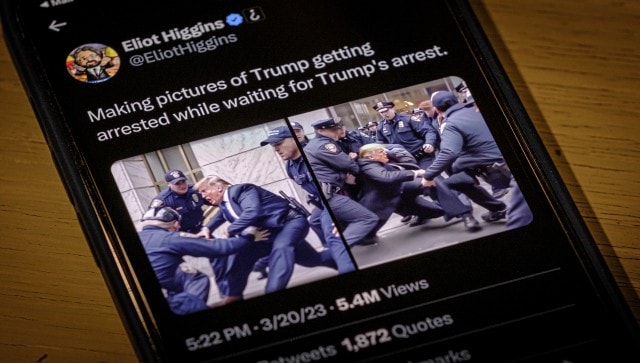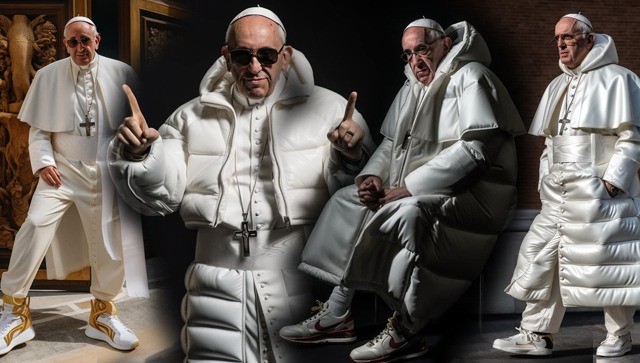These days, artificial Intelligence (AI) is all the rage with numerous depictions showing the reality of unfathomable situations. From former US president Barack Obama with former German chancellor Angela Merkel or Donald Trump’s ‘artificial’ arrest or Russian president Vladimir Putin in prison greys behind the bars, these images of made-up worlds ruled by the ‘Artificial’ branch of technological intelligence continue to pique people’s interest. Pope Francis, the leader of the Roman Catholic Church, recently became the focus of a few AI images , which pictured him wearing luxury clothing. Let’s take a closer look. Pope Francis in Balenciaga Pope Francis stunned onlookers after he appeared to stroll out in an extremely unconventional attire over the weekend. An image of the 86-year-old sitting pontiff wearing a long, white puffer jacket created by upscale fashion house Balenciaga took over the internet. Netizens praised the religious leader for his stylish decision, believing the image to be as accurate as the Bible itself. One of the users captioned the image, “The boys in Brooklyn could only hope for this level of drip.” More than 20.3 million people have seen the image and a fake flag has now been raised.
In several other pictures, Pope Francis was shown wearing crisp white trainers and elegant white gloves. Even though it may not have been too different from the Pope’s customarily formal attire but it was nonetheless completely fake. Chrissy Teigen, a devoted Twitter user and supermodel, was also duped by the nearly surrealistic photographs as she wrote on Saturday: “I thought the pope’s puffer jacket was real and didn’t give it a second thought. no way am I surviving the future of technology.”
“The pope’s puffer jacket is real if you want it to be,” singer-songwriter Finneas asserted in an Instagram Story on Sunday. The creator of ‘fake artificial image’ According to Buzzfeed News, Pablo Xavier, a 31-year-old construction worker from the Chicago region, has been named as the alleged creator of the image. Xavier, who wished to remain anonymous, told the publication that he was “tripping on shrooms” when he first started playing with Midjourney , an AI programme that can produce convincing fake visuals. In a statement, Pablo Xavier recalled, “It just dawned on me: I should do the Pope. Then it was just coming like water: ‘The Pope in Balenciaga puffy coat, Moncler, walking the streets of Rome, Paris,’ stuff like that.”
The meme maker said that after finishing his project, he posted the “perfect” images to Reddit and the AI Art Universe Facebook Group. But once it appeared on Twitter, the picture really took off. Pablo Xavier asserted that “I didn’t want it [the pictures] to blow up like that” and acknowledged that “people are running with it and thought it was real without questioning it.” “It’s crazy,” he lamented. Pope Francis on the emergence of AI technology According to CNN, during a conference at the Vatican on Monday, Pope Francis addressed the emergence of
AI technology
and urged scientists to examine its human impact (without specifically referring to the furore over his own appearance being faked). “I am convinced that the development of artificial intelligence and machine learning has the potential to contribute in a positive way to the future of humanity. I am certain that this potential will be realized only if there is a constant and consistent commitment on the part of those developing these technologies to act ethically and responsibly,” Pope Francis said. He added, “I would therefore encourage you, in your deliberations, to make the intrinsic dignity of every man and woman the key criterion in evaluating emerging technologies. These will prove ethically sound to the extent that they help respect that dignity and increase its expression at every level of human life.” AI imaging tools becoming more sophisticated According to Associated Press, while the ability to manipulate photos and create fake images isn’t new, AI image generator tools by Midjourney, DALL-E and others are easier to use. They can quickly generate realistic images — complete with detailed backgrounds — on a mass scale with little more than a simple text prompt from users. Some of the recent images have been driven by this month’s release of a new version of Midjourney’s text-to-image synthesis model, which can, among other things, now produce convincing images mimicking the style of news agency photos. In one widely-circulating Twitter thread, Eliot Higgins, founder of Bellingcat, a Netherlands-based investigative journalism collective, used the latest version of the tool to conjure up scores of dramatic images of Trump’s fictional arrest. The visuals, which have been shared and liked tens of thousands of times, showed a crowd of uniformed officers grabbing the Republican billionaire and violently pulling him down onto the pavement. [caption id=“attachment_12369192” align=“alignnone” width=“640”] The highly detailed, sensational images, which are not real, were produced using a sophisticated and widely accessible image generator. AP[/caption] Higgins, who was also behind a set of images of Putin being arrested, put on trial and then imprisoned, says he posted the images with no ill intent. He even stated clearly in his Twitter thread that the images were AI-generated. “The Trump arrest image was really just casually showing both how good and bad Midjourney was at rendering real scenes,” Higgins wrote in an email. “The images started to form a sort of narrative as I plugged in prompts to Midjourney, so I strung them along into a narrative, and decided to finish off the story.” He pointed out the images are far from perfect: in some, Trump is seen, oddly, wearing a police utility belt. In others, faces and hands are clearly distorted. Also read: Union Budget 2023-24 takes AI-forward approach to technology and fintech development
Experts’ warning Misinformation experts warn the images are harbingers of a new reality: waves of fake photos and videos flooding social media after major news events and further muddying fact and fiction at crucial times for society, reported AP. “It does add noise during crisis events. It also increases the cynicism level,” said Jevin West, a professor at the University of Washington in Seattle who focuses on the spread of misinformation. “You start to lose trust in the system and the information that you are getting.” With some generated images travelling on social networks and potentially going viral, they can be challenging to debunk since they can’t be traced back to a specific tool or data source, according to Chirag Shah, a professor at the Information School at the University of Washington, who uses these tools for research. “You could make some guesses if you have enough experience working with these tools,” Shah said. “But beyond that, there is no easy or scientific way to really do this.” Too often, the visuals are quickly reshared by others without that crucial context, Shirin Anlen, media technologist at Witness, a New York-based human rights organisation that focuses on visual evidence, said. Indeed, an Instagram post sharing some of Higgins’ images of Trump as if they were genuinely garnered more than 79,000 likes. “You’re just seeing an image, and once you see something, you cannot unsee it,” Anlen said. Best way to combat visual misinformation With synthetic images becoming increasingly difficult to discern from the real thing, the best way to combat visual misinformation is better public awareness and education, experts say. “It’s just becoming so easy and it’s so cheap to make these images that we should do whatever we can to make the public aware of how good this technology has gotten,” West said. Higgins suggests social media companies could focus on developing technology to detect AI-generated images and integrate that into their platforms. Twitter has a policy banning “synthetic, manipulated, or out-of-context media” with the potential to deceive or harm. Annotations from Community Notes, Twitter’s crowd-sourced fact-checking project, were attached to some tweets to include the context that the Trump images were AI-generated. With inputs from agencies Read all the
Latest News
,
Trending News
,
Cricket News
,
Bollywood News
, India News
and
Entertainment News
here. Follow us on
Facebook
,
Twitter
and
Instagram
.
The highly detailed, sensational images, which are not real, were produced using a sophisticated and widely accessible image generator. AP[/caption] Higgins, who was also behind a set of images of Putin being arrested, put on trial and then imprisoned, says he posted the images with no ill intent. He even stated clearly in his Twitter thread that the images were AI-generated. “The Trump arrest image was really just casually showing both how good and bad Midjourney was at rendering real scenes,” Higgins wrote in an email. “The images started to form a sort of narrative as I plugged in prompts to Midjourney, so I strung them along into a narrative, and decided to finish off the story.” He pointed out the images are far from perfect: in some, Trump is seen, oddly, wearing a police utility belt. In others, faces and hands are clearly distorted. Also read: Union Budget 2023-24 takes AI-forward approach to technology and fintech development
Experts’ warning Misinformation experts warn the images are harbingers of a new reality: waves of fake photos and videos flooding social media after major news events and further muddying fact and fiction at crucial times for society, reported AP. “It does add noise during crisis events. It also increases the cynicism level,” said Jevin West, a professor at the University of Washington in Seattle who focuses on the spread of misinformation. “You start to lose trust in the system and the information that you are getting.” With some generated images travelling on social networks and potentially going viral, they can be challenging to debunk since they can’t be traced back to a specific tool or data source, according to Chirag Shah, a professor at the Information School at the University of Washington, who uses these tools for research. “You could make some guesses if you have enough experience working with these tools,” Shah said. “But beyond that, there is no easy or scientific way to really do this.” Too often, the visuals are quickly reshared by others without that crucial context, Shirin Anlen, media technologist at Witness, a New York-based human rights organisation that focuses on visual evidence, said. Indeed, an Instagram post sharing some of Higgins’ images of Trump as if they were genuinely garnered more than 79,000 likes. “You’re just seeing an image, and once you see something, you cannot unsee it,” Anlen said. Best way to combat visual misinformation With synthetic images becoming increasingly difficult to discern from the real thing, the best way to combat visual misinformation is better public awareness and education, experts say. “It’s just becoming so easy and it’s so cheap to make these images that we should do whatever we can to make the public aware of how good this technology has gotten,” West said. Higgins suggests social media companies could focus on developing technology to detect AI-generated images and integrate that into their platforms. Twitter has a policy banning “synthetic, manipulated, or out-of-context media” with the potential to deceive or harm. Annotations from Community Notes, Twitter’s crowd-sourced fact-checking project, were attached to some tweets to include the context that the Trump images were AI-generated. With inputs from agencies Read all the
Latest News
,
Trending News
,
Cricket News
,
Bollywood News
, India News
and
Entertainment News
here. Follow us on
Facebook
,
Twitter
and
Instagram
.
)